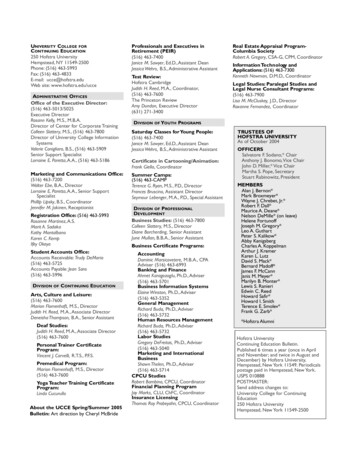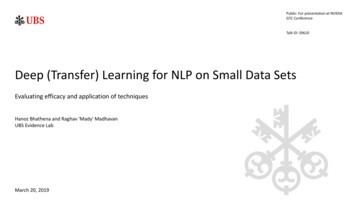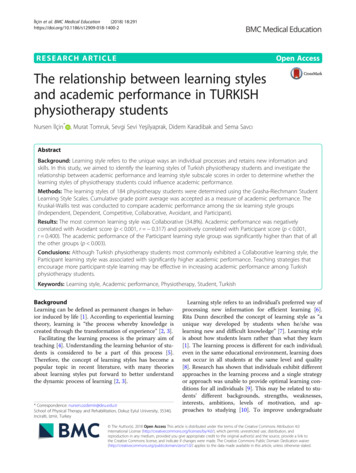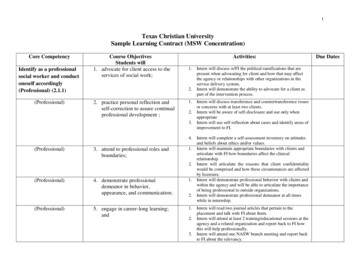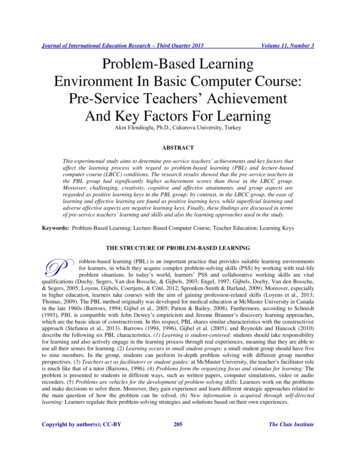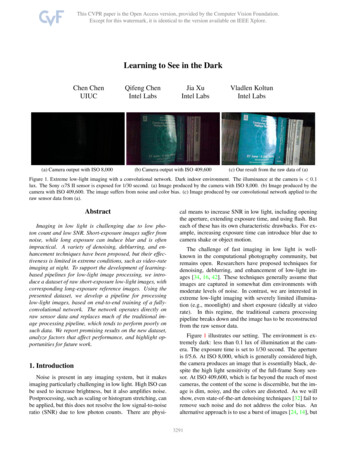
Transcription
Learning to See in the DarkChen ChenUIUC(a) Camera output with ISO 8,000Qifeng ChenIntel LabsJia XuIntel Labs(b) Camera output with ISO 409,600Vladlen KoltunIntel Labs(c) Our result from the raw data of (a)Figure 1. Extreme low-light imaging with a convolutional network. Dark indoor environment. The illuminance at the camera is 0.1lux. The Sony α7S II sensor is exposed for 1/30 second. (a) Image produced by the camera with ISO 8,000. (b) Image produced by thecamera with ISO 409,600. The image suffers from noise and color bias. (c) Image produced by our convolutional network applied to theraw sensor data from (a).AbstractImaging in low light is challenging due to low photon count and low SNR. Short-exposure images suffer fromnoise, while long exposure can induce blur and is oftenimpractical. A variety of denoising, deblurring, and enhancement techniques have been proposed, but their effectiveness is limited in extreme conditions, such as video-rateimaging at night. To support the development of learningbased pipelines for low-light image processing, we introduce a dataset of raw short-exposure low-light images, withcorresponding long-exposure reference images. Using thepresented dataset, we develop a pipeline for processinglow-light images, based on end-to-end training of a fullyconvolutional network. The network operates directly onraw sensor data and replaces much of the traditional image processing pipeline, which tends to perform poorly onsuch data. We report promising results on the new dataset,analyze factors that affect performance, and highlight opportunities for future work.1. IntroductionNoise is present in any imaging system, but it makesimaging particularly challenging in low light. High ISO canbe used to increase brightness, but it also amplifies noise.Postprocessing, such as scaling or histogram stretching, canbe applied, but this does not resolve the low signal-to-noiseratio (SNR) due to low photon counts. There are physi-cal means to increase SNR in low light, including openingthe aperture, extending exposure time, and using flash. Buteach of these has its own characteristic drawbacks. For example, increasing exposure time can introduce blur due tocamera shake or object motion.The challenge of fast imaging in low light is wellknown in the computational photography community, butremains open. Researchers have proposed techniques fordenoising, deblurring, and enhancement of low-light images [34, 16, 42]. These techniques generally assume thatimages are captured in somewhat dim environments withmoderate levels of noise. In contrast, we are interested inextreme low-light imaging with severely limited illumination (e.g., moonlight) and short exposure (ideally at videorate). In this regime, the traditional camera processingpipeline breaks down and the image has to be reconstructedfrom the raw sensor data.Figure 1 illustrates our setting. The environment is extremely dark: less than 0.1 lux of illumination at the camera. The exposure time is set to 1/30 second. The apertureis f/5.6. At ISO 8,000, which is generally considered high,the camera produces an image that is essentially black, despite the high light sensitivity of the full-frame Sony sensor. At ISO 409,600, which is far beyond the reach of mostcameras, the content of the scene is discernible, but the image is dim, noisy, and the colors are distorted. As we willshow, even state-of-the-art denoising techniques [32] fail toremove such noise and do not address the color bias. Analternative approach is to use a burst of images [24, 14], but13291
burst alignment algorithms may fail in extreme low-lightconditions and burst pipelines are not designed for videocapture (e.g., due to the use of ‘lucky imaging’ within theburst).We propose a new image processing pipeline that addresses the challenges of extreme low-light photography viaa data-driven approach. Specifically, we train deep neuralnetworks to learn the image processing pipeline for lowlight raw data, including color transformations, demosaicing, noise reduction, and image enhancement. The pipelineis trained end-to-end to avoid the noise amplification anderror accumulation that characterize traditional camera processing pipelines in this regime.Most existing methods for processing low-light imageswere evaluated on synthetic data or on real low-light images without ground truth. To the best of our knowledge,there is no public dataset for training and testing techniquesfor processing fast low-light images with diverse real-worlddata and ground truth. Therefore, we have collected a newdataset of raw images captured with fast exposure in lowlight conditions. Each low-light image has a correspondinglong-exposure high-quality reference image. We demonstrate promising results on the new dataset: low-light images are amplified by up to 300 times with successful noisereduction and correct color transformation. We systematically analyze key elements of the pipeline and discuss directions for future research.also been studied, including recent work that uses deep networks [15, 10], but these methods have been evaluated onsynthetic Bayer patterns and synthetic noise, rather than realimages collected in extreme low-light conditions.In addition to single-image denoising, multiple-imagedenoising has also been considered and can achieve better results since more information is collected from thescene [31, 23, 19, 24, 14, 29]. In particular, Liu et al. [24]and Hasinoff et al. [14] propose to denoise a burst of images from the same scene. While often effective, thesepipelines can be elaborate, involving reference image selection (‘lucky imaging’) and dense correspondence estimationacross images. We focus on a complementary line of investigation and study how far single-image processing can bepushed.Computational processing of low-light images has beenextensively studied in the literature. We provide a short review of existing methods.Low-light image enhancement. A variety of techniqueshave been applied to enhance the contrast of low-light images. One classic choice is histogram equalization, whichbalances the histogram of the entire image. Another widelyused technique is gamma correction, which increases thebrightness of dark regions while compressing bright pixels. More advanced methods perform more global analysisand processing, using for example the inverse dark channel prior [8, 29], the wavelet transform [27], the Retinexmodel [30], and illumination map estimation [13]. However, these methods generally assume that the images already contain a good representation of the scene content.They do not explicitly model image noise and typically apply off-the-shelf denoising as a postprocess. In contrast, weconsider extreme low-light imaging, with severe noise andcolor distortion that is beyond the operating conditions ofexisting enhancement pipelines.Image denoising. Image denoising is a well-developedtopic in low-level vision. Many approaches have beenproposed, using techniques such as total variation [36],wavelet-domain processing [33], sparse coding [9, 28], nuclear norm minimization [12], and 3D transform-domain filtering (BM3D) [7]. These methods are often based on specific image priors such as smoothness, sparsity, low rank,or self-similarity. Researchers have also explored the application of deep networks to denoising, including stackedsparse denoising auto-encoders (SSDA) [39, 1], trainablenonlinear reaction diffusion (TNRD) [6], multi-layer perceptrons [3], deep autoencoders [26], and convolutionalnetworks [17, 41]. When trained on certain noise levels,these data-driven methods can compete with state-of-theart classic techniques such as BM3D and sparse coding.Unfortunately, most existing methods have been evaluatedon synthetic data, such as images with added Gaussian orsalt&pepper noise. A careful recent evaluation with realdata found that BM3D outperforms more recent techniqueson real images [32]. Joint denoising and demosaicing hasNoisy image datasets. Although there are many studiesof image denoising, most existing methods are evaluatedon synthetic data, such as clean images with added Gaussian or salt&pepper noise. The RENOIR dataset [2] wasproposed to benchmark denoising with real noisy images.However, as reported in the literature [32], image pairs inthe RENOIR dataset exhibit spatial misalignment. Burstsof images have been used to reduce noise in low-light conditions [24], but the associated datasets do not contain reliable ground-truth data. The Google HDR dataset [14]does not target extreme low-light imaging: most images inthe dataset were captured during the day. The recent Darmstadt Noise Dataset (DND) [32] aims to address the need forreal data in the denoising community, but the images werecaptured during the day and are not suitable for evaluationof low-light image processing. To the best of our knowledge, there is no public dataset with raw low-light imagesand corresponding ground truth. We therefore collect sucha dataset to support systematic reproducible research in thisarea.2. Related Work3292
Sony α7S IIFilter arrayExposure time (s)# imagesx300x250x100BayerBayerBayer1/10, 1/301/251/101190699808Fujifilm X-T2Filter arrayExposure time (s)# 06306501117Table 1. The See-in-the-Dark (SID) dataset contains 5094 rawshort-exposure images, each with a reference long-exposure image. The images were collected by two cameras (top and bottom).From left to right: ratio of exposure times between input and reference images, filter array, exposure time of input image, and number of images in each condition.3. See-in-the-Dark DatasetWe collected a new dataset for training and benchmarking single-image processing of raw low-light images. TheSee-in-the-Dark (SID) dataset contains 5094 raw shortexposure images, each with a corresponding long-exposurereference image. Note that multiple short-exposure imagescan correspond to the same long-exposure reference image.For example, we collected sequences of short-exposure images to evaluate burst denoising methods. Each image in thesequence is counted as a distinct low-light image, since eachsuch image contains real imaging artifacts and is useful fortraining and testing. The number of distinct long-exposurereference images in SID is 424.The dataset contains both indoor and outdoor images.The outdoor images were generally captured at night, undermoonlight or street lighting. The illuminance at the camerain the outdoor scenes is generally between 0.2 lux and 5 lux.The indoor images are even darker. They were captured inclosed rooms with regular lights turned off and with faint indirect illumination set up for this purpose. The illuminanceat the camera in the indoor scenes is generally between 0.03lux and 0.3 lux.The exposure for the input images was set between 1/30and 1/10 seconds. The corresponding reference (groundtruth) images were captured with 100 to 300 times longerexposure: i.e., 10 to 30 seconds. Since exposure times forthe reference images are necessarily long, all the scenes inthe dataset are static. The dataset is summarized in Table 1.A small sample of reference images is shown in Figure 2.Approximately 20% of the images in each condition are randomly selected to form the test set, and another 10% areselected for the validation set.Images were captured using two cameras: Sony α7SII and Fujifilm X-T2. These cameras have different sensors: the Sony camera has a full-frame Bayer sensor andFigure 2. Example images in the SID dataset. Outdoor imagesin the top two rows, indoor images in the bottom rows. Longexposure reference (ground truth) images are shown in front.Short-exposure input images (essentially black) are shown in theback. The illuminance at the camera is generally between 0.2 and5 lux outdoors and between 0.03 and 0.3 lux indoors.the Fuji camera has an APS-C X-Trans sensor. This supports evaluation of low-light image processing pipelines onimages produced by different filter arrays. The resolution is4240 2832 for Sony and 6000 4000 for the Fuji images.The Sony set was collected using two different lenses.The cameras were mounted on sturdy tripods. We usedmirrorless cameras to avoid vibration due to mirror flapping. In each scene, camera settings such as aperture, ISO,focus, and focal length were adjusted to maximize the quality of the reference (long-exposure) images. After a longexposure reference image was taken, a remote smartphoneapp was used to decrease the exposure time by a factor of100 to 300 for a sequence of short-exposure images. Thecamera was not touched between the long-exposure and theshort-exposure images. We collected sequences of shortexposure images to support comparison with an idealizedburst-imaging pipeline that benefits from perfect alignment.The long-exposure reference images may still containsome noise, but the perceptual quality is sufficiently highfor these images to serve as ground truth. We target applications that aim to produce perceptually good images inlow-light conditions, rather than exhaustively removing allnoise or maximizing image contrast.4. Method4.1. PipelineAfter getting the raw data from an imaging sensor, thetraditional image processing pipeline applies a sequence of3293
RawDataDataRawRawBurstAlign &MergeDenoise,SharpenDemosaicLearning DenoiseLocal tonemapColor aze,Global tonemapSharpen,hue &saturationOutputOutputOutput(a) Amplification Ratio ConvNetBlack LevelBayer RawOutput RGB(b)Figure 3. The structure of different image processing pipelines. (a) From top to bottom: a traditional image processing pipeline, the L3pipeline [18], and a burst imaging pipeline [14]. (b) Our pipeline.modules such as white balance, demosaicing, denoising,sharpening, color space conversion, gamma correction, andothers. These modules are often tuned for specific cameras.Jiang et al. [18] proposed to use a large collection of local, linear, and learned (L3) filters to approximate the complex nonlinear pipelines found in modern consumer imaging systems. Yet neither the traditional pipeline nor the L3pipeline successfully deal with fast low-light imaging, asthey are not able to handle the extremely low SNR. Hasinoffet al. [14] described a burst imaging pipeline for smartphonecameras. This method can produce good results by aligningand blending multiple images, but introduces a certain levelof complexity, for example due to the need for dense correspondence estimation, and may not easily extend to videocapture, for example due to the use of lucky imaging.We propose to use end-to-end learning for direct singleimage processing of fast low-light images. Specifically, wetrain a fully-convolutional network (FCN) [22, 25] to perform the entire image processing pipeline. Recent work hasshown that pure FCNs can effectively represent many image processing algorithms [40, 5]. We are inspired by thiswork and investigate the application of this approach to extreme low-light imaging. Rather than operating on normalsRGB images produced by traditional camera processingpipelines, we operate on raw sensor data.Figure 3(b) illustrates the structure of the presentedpipeline. For Bayer arrays, we pack the input into fourchannels and correspondingly reduce the spatial resolutionby a factor of two in each dimension. For X-Trans arrays(not shown in the figure), the raw data is arranged in 6 6blocks; we pack it into 9 channels instead of 36 channels byexchanging adjacent elements. We subtract the black leveland scale the data by the desired amplification ratio (e.g.,x100 or x300). The packed and amplified data is fed intoa fully-convolutional network. The output is a 12-channelimage with half the spatial resolution. This half-sized output is processed by a sub-pixel layer to recover the originalresolution [37].After preliminary exploration, we have focused on twogeneral structures for the fully-convolutional network thatforms the core of our pipeline: a multi-scale context aggregation network (CAN) recently used for fast image processing [5] and a U-net [35]. Other work has explored residualconnections [20, 34, 41], but we did not find these beneficial in our setting, possibly because our input and outputare represented in different color spaces. Another consideration that affected our choice of architectures is memoryconsumption: we have chosen architectures that can processa full-resolution image (e.g., at 4240 2832 or 6000 4000resolution) in GPU memory. We have therefore avoided3294
(a) x28(c) x189(b) x87(d) x366Figure 4. The effect of the amplification factor on a patch from an indoor image in the SID dataset (Sony x100 subset). The amplificationfactor is provided as an external input to our pipeline, akin to the ISO setting in cameras. Higher amplification factors yield brighter images.This figure shows the output of our pipeline with different amplification factors.fully-connected layers that require processing small imagepatches and reassembling them [26]. Our default architecture is the U-net [35].The amplification ratio determines the brightness of theoutput. In our pipeline, the amplification ratio is set externally and is provided as input to the pipeline, akin to theISO setting in cameras. Figure 4 shows the effect of different amplification ratios. The user can adjust the brightness of the output image by setting different amplificationfactors. At test time, the pipeline performs blind noise suppression and color transformation. The network outputs theprocessed image directly in sRGB space.4.2. TrainingWe train the networks from scratch using the L1 loss andthe Adam optimizer [21]. During training, the input to thenetwork is the raw data of the short-exposed image and theground truth is the corresponding long-exposure image insRGB space (processed by libraw, a raw image processing library). We train one network for each camera. Theamplification ratio is set to be the exposure difference between the input and reference images (e.g., x100, x250, orx300) for both training and testing. In each iteration, werandomly crop a 512 512 patch for training and apply random flipping and rotation for data augmentation. The learning rate is initially set to 10 4 and is reduced to 10 5 after2000 epochs. Training proceeds for 4000 epochs.5. Experiments5.1. Qualitative results and perceptual experimentsComparison to traditional pipeline. Our initial baseline isthe traditional camera processing pipeline, with amplification prior to quantization. (We use the same amplificationratio as the one given to our pipeline.) Qualitative comparisons to this baseline are shown in Figures 5, 6, and 7.Images produced by the traditional pipeline in extreme lowlight conditions suffer from severe noise and color distortion.Comparison to denoising and burst processing. The natural next step is to apply an existing denoising algorithmpost-hoc to the output of the traditional pipeline. A carefulrecent evaluation on real data has shown that BM3D [7] outperforms more recent denoising models on real images [32].We thus use BM3D as the reference denoising algorithm.Figure 7 illustrates the results. Note that BM3D is a nonblind denoising method and requires the noise level to bespecified extrinsically as a parameter. A small noise levelsetting may leave perceptually significant noise in the image, while a large level may over-smooth. As shown in Figure 7, the two effects can coexist in the same image, sinceuniform additive noise is not an appropriate model for reallow-light images. In contrast, our pipeline performs blindnoise suppression that can locally adapt to the data. Furthermore, post-hoc denoising does not address other artifacts present in the output of the traditional pipeline, suchas color distortion.We also compare to burst denoising [24, 14]. Since image sequences in our dataset are already aligned, the burstimaging pipeline we compare to is idealized: it benefitsfrom perfect alignment, which is not present in practice.Since alignment is already taken care of, we perform burstdenoising by taking the per-pixel median for a sequence of8 images.Comparison in terms of PSNR/SSIM using the referencelong-exposure images would not be fair to BM3D and burstprocessing, since these baselines have to use input imagesthat undergo different processing. For fair comparison, wereduce color bias by using the white balance coefficientsof the reference image. In addition, we scale the imagesgiven to the baselines channel-by-channel to the same meanvalues as the reference image. These adjustments bring theimages produced by the baselines closer in appearance tothe reference image in terms of color and brightness. Notethat this amounts to using privileged information to help thebaselines.To evaluate the relative quality of images produced byour pipeline, BM3D denoising, and burst denoising, weconduct a perceptual experiment based on blind randomized3295
(a) JPEG image produced by camera(b) Raw data via traditional pipeline(c) Our resultFigure 5. (a) An image captured at night by the Fujifilm X-T2 camera with ISO 800, aperture f/7.1, and exposure of 1/30 second. Theilluminance at the camera is approximately 1 lux. (b) Processing the raw data by a traditional pipeline does not effectively handle the noiseand color bias in the data. (c) Our result obtained from the same raw data.A/B tests deployed on the Amazon Mechanical Turk platform [4]. Each comparison presents corresponding imagesproduced by two different pipelines to an MTurk worker,who has to determine which image has higher quality. Image pairs are presented in random order, with random leftright order, and no indication of the provenance of differentimages. A total of 1180 comparisons were performed by 10MTurk workers. Table 2 shows the rates at which workerschose an image produced by the presented pipeline over acorresponding image produced by one of the baselines. Weperformed the experiment with images from two subsets ofthe test set: Sony x300 (challenging) and Sony x100 (easier). Our pipeline significantly outperforms the baselineson the challenging x300 set and is on par on the easier x100set. Recall that the experiment is skewed in favor of thebaselines due to the oracle preprocessing of the data provided to the baselines. Note also that burst denoising usesinformation from 8 images with perfect alignment.Ours BM3DOurs BurstSony x300 setSony x100 set92.4%85.2%59.3%47.3%Table 2. Perceptual experiments were used to compare the presented pipeline with BM3D and burst denoising. The experimentis skewed in favor of the baselines, as described in the text. Thepresented single-image pipeline still significantly outperforms thebaselines on the challenging x300 set and is on par on the easierx100 set.Qualitative results on smartphone images. We expectthat best results will be obtained when a dedicated networkis trained for a specific camera sensor. However, our preliminary experiments with cross-sensor generalization indicatethat this may not always be necessary. We have applied amodel trained on the Sony subset of SID to images capturedby an iPhone 6s smartphone, which also has a Bayer filterarray and 14-bit raw data. We used an app to manually set(a) Traditional pipeline(b) Our resultFigure 6. Application of a network trained on SID to a low-lightraw image taken with an iPhone 6s smartphone. (a) A raw imagecaptured at night with an iPhone 6s with ISO 400, aperture f/2.2,and exposure time 0.05s. This image was processed by the traditional image processing pipeline and scaled to match the brightness of the reference image. (b) The output of our network, withamplification ratio x100.ISO and other parameters, and exported raw data for processing. A representative result is shown in Figure 6. Thelow-light data processed by the traditional pipeline suffersfrom severe noise and color shift. The result of our network, trained on images from a different camera, has goodcontrast, low noise, and well-adjusted color.5.2. Controlled experimentsTable 3 (first row) reports the accuracy of the presentedpipeline in terms of Peak Signal-to-Noise Ratio (PSNR) andStructural SIMilarity (SSIM) [38]. We now describe a sequence of controlled experiments that evaluate the effect ofdifferent elements in the pipeline.3296
(a) Traditional pipeline(b) . followed by BM3D denoising(c) Our resultFigure 7. An image from the Sony x300 set. (a) Low-light input processed by the traditional image processing pipeline and linear scaling.(b) Same, followed by BM3D denoising. (c) Our result.Condition1.2.3.4.5.6.7.8.Our default pipelineU-net CANRaw sRGBL1 SSIM lossL1 L2 lossPacked MaskedX-Trans 3 3 6 6Stretched 680–23.05/0.56716.85/0.535Table 3. Controlled experiments.PSNR/SSIM in each condition.This table reports meanNetwork structure. We begin by comparing different network architectures. Table 3 (row 2) reports the result ofreplacing the U-net [35] (our default architecture) by theCAN [5]. The U-net has higher PSNR on both sets. Although images produced by the CAN have higher SSIM,they sometimes suffer from loss of color. A patch from theFuji x300 set is shown in Figure 8. Here colors are not recovered correctly by the CAN.(a) CAN(b) U-netFigure 8. Comparison of network architectures on an image patchfrom the Fuji x300 test set. (a) Using the CAN structure, the coloris not recovered correctly. (b) Using the U-net. Zoom in for detail.Input color space. Most existing denoising methods operate on sRGB images that have already been processed by atraditional image processing pipeline. We have found thatoperating directly on raw sensor data is much more effectivein extreme low-light conditions. Table 3 (row 3) shows theresults of the presented pipeline when it’s applied to sRGBimages produced by the traditional pipeline.Loss functions. We use the L1 loss by default, but haveevaluated many alternative loss functions. As shown inTable 3 (rows 4 and 5), replacing the L1 loss by L2 orSSIM [43] produces comparable results. We have not observed systematic perceptual benefits for any one of theseloss functions. Adding a total variation loss does not improve accuracy. Adding a GAN loss [11] significantly reduces accuracy.Data arrangement. The raw sensor data has all colors in asingle channel. Common choices for arranging raw data fora convolutional network are packing the color values intodifferent channels with correspondingly lower spatial resolution, or duplicating and masking different colors [10]. Weuse packing by default. As shown in Table 3 (row 6), masking the Bayer data (Sony subset) yields lower PSNR/SSIMthan packing; a typical perceptual artifact of the maskingapproach is loss of some hues in the output.The X-Trans data is very different in structure from theBayer data and is arranged in 6 6 blocks. One option isto pack it into 36 channels. Instead, we exchange some values between neighboring elements to create a 3 3 pattern,which is packed into 9 channels. As shown in Table 3 (row7), 6 6 packing yields lower PSNR/SSIM; a typical perceptual artifact is loss of color and detail.Postprocessing. In initial experiments, we included histogram stretching in the processing pipeline for the reference images. Thus the network had to learn histogramstretching in addition to the rest of the processing pipeline.Despite trying many network architectures and loss functions, we were not successful in training networks to per3297
(a)(b)(a) Traditional pipeline(b) . followed by BM3D(c)(d)(c) Burst denoising(d) Our resultFigure 9. Effect of histogram stretching. (a) A reference image inthe Sony x100 set, produced with histogram stretching. (b) Outputif trained on histogram-stretched images. The result suffers fromartifacts on the wall. (c) Output if trained on images without histogram stretching. The result is darker but cleaner. (d) The image(c) after histogram stretching applied in postprocessing.form this task. As shown in Table 3 (row 8), the accuracyof the network drops significantly when histogram stretching is applied to the reference images (and thus the networkhas to learn histogram stretching). Our experiments suggest that our pipeline does not easily learn to model andmanipulate global histogram statistics across the entire image, and is prone to overfitting the training data when facedwith this task. We thus exclude histogram stretching fromthe pipeline and optionally apply it as postprocessing. Figure 9 shows a typical result in which attempting to learnhistogram stretching yields visible artifacts at test time. Theresult of training on unstretched reference images is darkerbut cleaner.6. DiscussionFast low-light imaging is a formidable challenge due tolow photon counts and low SNR. Imaging in the dark, atvideo rates, in sub-lux conditions, is considered impracticalwith traditional signal processing techniques. In this paper, we presented the See-in-the-Dark (SID) dataset, created to support the development of data-driven approachesthat may enable such extreme imaging. Using SID, we havedeveloped a simple pipeline that improves upon traditionalprocessing of low-light images. The presented pipeline isbased on end-to-end training of a fully-convolutional network. Experiments demonstrate promising results, withsuccessful noise suppression and correct color transformation on SID data.The presented work opens many opportunities for futureFigure 10. Limited signal recovery in extreme low-light conditions(indoor, dark room, 0.2 lux). (a) An input image in the Sony x300set, processed by the traditional pipeline and amplified to matchthe reference. (b) BM3D denoising applied to (a). (
Learning to See in the Dark Chen Chen UIUC Qifeng Chen Intel Labs Jia Xu Intel Labs Vladlen Koltun Intel Labs (a) Camera output with ISO 8,000 (b) Camera output with ISO 409,600 (c) Our result from the raw data of (a) Figure 1. Extreme low-light imaging with a convolutional network. Dark indoor




